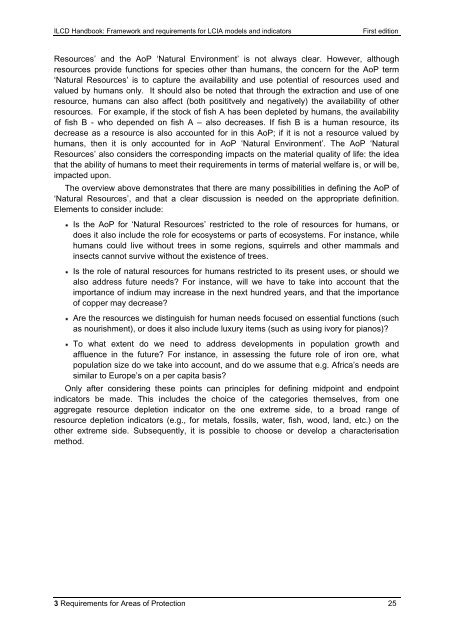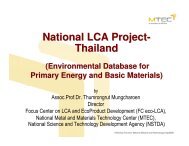ILCD Handbook: Framework and requirements for LCIA models and ...
ILCD Handbook: Framework and requirements for LCIA models and ...
ILCD Handbook: Framework and requirements for LCIA models and ...
You also want an ePaper? Increase the reach of your titles
YUMPU automatically turns print PDFs into web optimized ePapers that Google loves.
<strong>ILCD</strong> <strong>H<strong>and</strong>book</strong>: <strong>Framework</strong> <strong>and</strong> <strong>requirements</strong> <strong>for</strong> <strong>LCIA</strong> <strong>models</strong> <strong>and</strong> indicators First edition<br />
Resources‘ <strong>and</strong> the AoP ‗Natural Environment‘ is not always clear. However, although<br />
resources provide functions <strong>for</strong> species other than humans, the concern <strong>for</strong> the AoP term<br />
‗Natural Resources‘ is to capture the availability <strong>and</strong> use potential of resources used <strong>and</strong><br />
valued by humans only. It should also be noted that through the extraction <strong>and</strong> use of one<br />
resource, humans can also affect (both posititvely <strong>and</strong> negatively) the availability of other<br />
resources. For example, if the stock of fish A has been depleted by humans, the availability<br />
of fish B - who depended on fish A – also decreases. If fish B is a human resource, its<br />
decrease as a resource is also accounted <strong>for</strong> in this AoP; if it is not a resource valued by<br />
humans, then it is only accounted <strong>for</strong> in AoP ‗Natural Environment‘. The AoP ‗Natural<br />
Resources‘ also considers the corresponding impacts on the material quality of life: the idea<br />
that the ability of humans to meet their <strong>requirements</strong> in terms of material welfare is, or will be,<br />
impacted upon.<br />
The overview above demonstrates that there are many possibilities in defining the AoP of<br />
‗Natural Resources‘, <strong>and</strong> that a clear discussion is needed on the appropriate definition.<br />
Elements to consider include:<br />
Is the AoP <strong>for</strong> ‗Natural Resources‘ restricted to the role of resources <strong>for</strong> humans, or<br />
does it also include the role <strong>for</strong> ecosystems or parts of ecosystems. For instance, while<br />
humans could live without trees in some regions, squirrels <strong>and</strong> other mammals <strong>and</strong><br />
insects cannot survive without the existence of trees.<br />
Is the role of natural resources <strong>for</strong> humans restricted to its present uses, or should we<br />
also address future needs? For instance, will we have to take into account that the<br />
importance of indium may increase in the next hundred years, <strong>and</strong> that the importance<br />
of copper may decrease?<br />
Are the resources we distinguish <strong>for</strong> human needs focused on essential functions (such<br />
as nourishment), or does it also include luxury items (such as using ivory <strong>for</strong> pianos)?<br />
To what extent do we need to address developments in population growth <strong>and</strong><br />
affluence in the future? For instance, in assessing the future role of iron ore, what<br />
population size do we take into account, <strong>and</strong> do we assume that e.g. Africa‘s needs are<br />
similar to Europe‘s on a per capita basis?<br />
Only after considering these points can principles <strong>for</strong> defining midpoint <strong>and</strong> endpoint<br />
indicators be made. This includes the choice of the categories themselves, from one<br />
aggregate resource depletion indicator on the one extreme side, to a broad range of<br />
resource depletion indicators (e.g., <strong>for</strong> metals, fossils, water, fish, wood, l<strong>and</strong>, etc.) on the<br />
other extreme side. Subsequently, it is possible to choose or develop a characterisation<br />
method.<br />
3 Requirements <strong>for</strong> Areas of Protection 25



